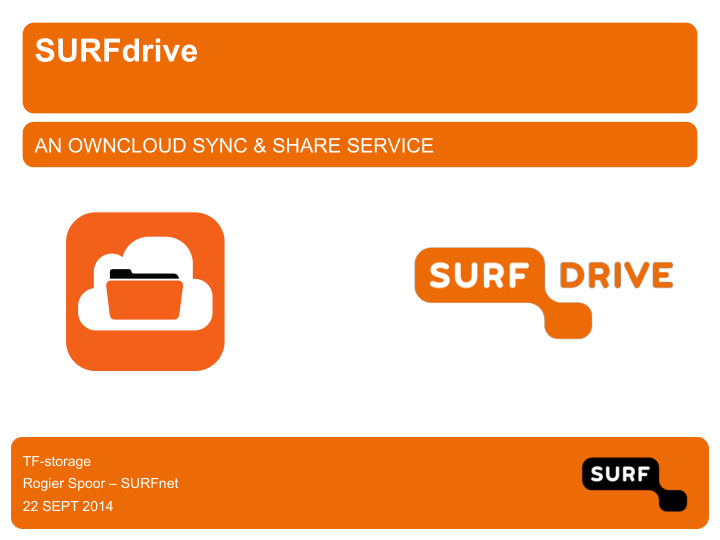



SURFdrive AN OWNCLOUD SYNC & SHARE SERVICE TF-storage Rogier Spoor – SURFnet 22 SEPT 2014
Top 5 reasons to use a personal cloud storage solution • Users always have access to their 1 documents, regardless of the location or device 2 • Documents can easily be shared with others 3 • The available solutions are user-friendly 4 • Resolves storage restrictions 5 • To encourage providers to keep the entry threshold as low as possible (free)
Top 5 reasons why this is less desirable 1 • Privacy and security are not guaranteed, rights are being given away, PRISM 2 • Mainly US-based providers, à Patriot Act 3 • Lack of legal protection, no SLA 4 • Data ownership, data is no longer available once participant leaves the institution • Privacy and publication terms and conditions do 5 not meet education and research community requirements
What does SURFdrive offer? in accordance SURFdrive with the Legal offers the same Framework for level of user- Cloud Services friendliness as in Higher Dropbox Education Data is stored Makes it easy to within SURF In share data within accordance with the community the highest and allows for privacy and guest use security through requirements SURFconext
Top 5 reasons to use SURFdrive Privacy /Security 1 • Data is stored in data centres managed by SURF and/ or institutions 2 • Processes are established in accordance with the high risk category defined in the Legal Framework • The community defines its own terms and conditions 3 regarding usage, sharing and termination of the services • Data ownership: data remains available (under the 4 institution's control) when staff members leave the institution 5 • Privacy and publication terms and conditions meet the requirements imposed by the academic world
SURFdrive service description • Under development: • Features • New functionalities added on a continual • Storage : 100 GB basis • 20 * carryover • Maintenance portal • Access to SURFconext • Webdav connection (iAnnotate) • High standard of privacy / security • Availability • Guest use • 99.5 % April 2014 Sync app MS, Linux, iOS • 99.9 % January 2015 • • Monitoring • Mobile Apps: iOS, Android • April 2014, during office hours • 1 January 2015 or earlier 7*16 • Support • DIYS (end users) By institutions (first-line) •
Framework Standards for HE&R Has been prepared to establish reliable and secure cloud services and set standards in the field of: - confidentiality - privacy - Intellectual property - availability
Timelines • End 2013, selection process 1 • 22 Januari start pilot Owncloud 2 • March: evaluation pilot, service discription & pricing 3 • March go/no-go SURFdrive dienst 4 • June start SURFdrive service 5
Actual usage
Security Operational Policy • Best practices check • Framework Standards for HE • Vulnerability scan • Data classification • Pentest webenvironment • Highest level classification <-> usability • SSLtest Qualys -> A+ • Collaborate with security community • Procedures (changes, incidents, testing) Todo • Audit ISO 2700x • TPM
Crypto challenges • SSL and single layer defence approach • Trust & TLS • wish: full encryption of files (not available in OC) • problem: how to share? • In you domain: doable • External share: challenge • Howto de-encrypt in webGUI? • Browsers don’t have (yet) sufficient crypto lib • Javascript crypto is feasible • How distribute password or keys • Password reset by admin? • Or dataloss when password forgotten
Federation integration • Federated login, institute able to provision users • Federation = SAML = web based • Web based SSO just works • OC enterprise supports Shibboleth (SAML) • Howto integrate Owncloud service • Sync clients (OSX, Windows, Linux) • Mobile (IOS, Android) -> OC uses embedded browser for Shib-login • Disadvantage: two sessions (1x Shib , 1x OC)
Federation lessons learned • Embedded browser construction tricky • Difficult know works all institute LAN • Automated testing is needed (by OC) • WebDAV = basic authentication • Federation = http redirects • OC webdav not available when using Shib-login
Which developments can we expect to see in future? 1 • Broader use will reduce costs 2 • Institutions assign rights to users 3 • Institutions share storage environments (Federated) 4 • Expansion of functionalities 5 • Expansion of storage capacity 6 • In the event of proven success, a greater number of community cloud services will be offered through the SURF Community Cloud
What are the biggest challenges? 1 • Maximising the number of participants per institution 2 • Maximising the number of participating institutions • Convincing end users of the benefits and need 3 • Privacy and security • Value of the network increases as the number participants is squared • Heightened importance as more participants can share information 4 • Minimising costs while maximising security and privacy
Market developments Large number of players De facto standard Market is diversifying Large number of new features Varied pricing Suppliers are choosing their own approaches
Why is the solution attractive to end users? 1 • 100 GB capacity (free of charge) 2 • Allows for collaboration with colleagues, other higher education and research institutions 3 • Files can be accessed from any device 4 • Allows for sharing with guest users in any location around the world 5 • Secure and protected against the invasion of privacy, within the Dutch legal framework
Questions?
Recommend
More recommend